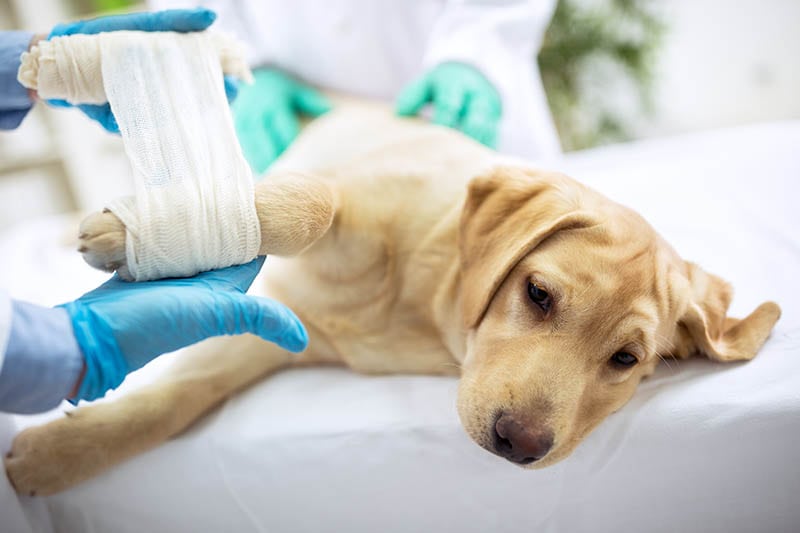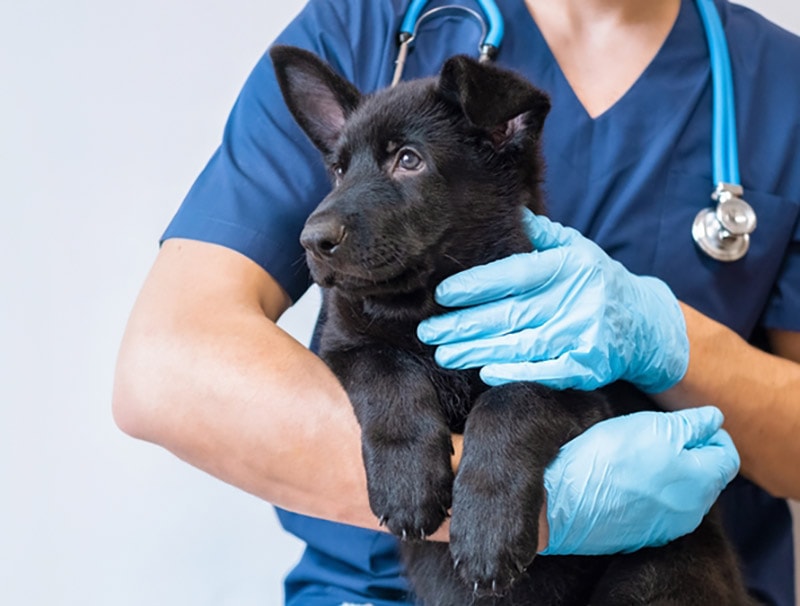
Puppies have a habit of getting into tricky situations; the world is new and exciting, and they like exploring everything their environment offers. They are also still growing and developing, so it’s easy to overdo it and sustain an injury.
Limping is never normal for a dog, but the causes behind it can vary from mild to serious. So, we’ve broken down all the most common reasons why your puppy might be limping and what you should do about it.
Before You Start
There are two types of limping: gradual and sudden onset. As the names suggest, gradual limping will come on over time, while sudden onset limping comes on quickly.
Knowing which type your pet has will help your vet and will also give you an indication if the limp is an emergency. Gradual onset limping is generally caused by chronic conditions, like dysplasia, which warrants a vet visit but not necessarily immediately. Sudden onset limping is generally caused by trauma or injury, which often requires immediate attention. Gradual onset limping might seem less urgent, but some causes, such as hip dysplasia, can be more effectively treated if caught sooner.
The 5 Common Reasons Your Puppy is Limping
1. Trauma or Injury
Puppies are active. Puppies are clumsy. This is often a recipe for some minor bumps, scrapes, falls, and strains, all of which can leave your puppy limping. Puppies also have a knack for knowing where you’re going to walk and then getting under your feet. This makes getting stepped on another common injury that causes limping in puppies. Most of the time, these injuries are minor bruises or sprains that create mild, often short-lived pain in your pup’s limbs. If their limping doesn’t resolve, or gets worse, within a day or two, call your veterinarian.
However, that same recipe of activity and clumsiness can also lead to more severe injuries, such as dislocations, fractures, or connective tissue tears. So, how do you tell what needs vet attention and what just needs a little TLC?
As a general rule, give your puppy a few minutes to rest and let the initial shock of the injury wear off. If your puppy is still limping after 15-20 minutes of rest, consider calling your veterinarian. Of course, if you notice an obvious injury, such an awkward angle to your pup’s leg or they won’t bear weight on it, call your veterinarian sooner rather than later.

2. Minor Paw Injuries
Any injury to your puppy’s paw can create pain and discomfort, and therefore, limping in puppies. Getting a foreign object, like a thorn, stick, or sharp object, as well as broken toenails, bruises, burns, or cuts, to name a few, are all possible injuries to a paw. If your puppy is licking their paw more than usual, or you notice swelling, or a wound, talk to your veterinarian. If left untreated, some paw injuries can lead to an infection.
3. Joint Diseases
Signs of joint disease like hip or elbow dysplasia typically show up as a dog ages, but some severe cases may cause limping in puppies. Other joint problems like luxating patellas, osteochondritis dissecans (OCD), and hypertrophic osteodystrophy are all possibilities of limping puppies and should be checked out by a vet.

4. Bone Disease
Large-breed puppies are more susceptible to some bony conditions like panosteitis which makes walking painful. Panosteitis will typically resolve on its own as your puppy matures, but they may require pain medications or anti-inflammatories to help with the discomfort.
Though very rare for puppies, and even adult dogs under 18-24 months of age, your vet may need to rule out cancer as a possible cause of your puppy’s extreme pain and limping. Contact your vet as soon as possible if you notice a consistent and very painful lameness because the sooner these problems are diagnosed, the better the prognosis.
5. Tick-Borne Diseases
Several species of ticks are active in the United States that feed on dogs. While ticks spread tick-borne diseases, the illnesses aren’t actually caused by ticks. Instead, they are a result of ticks that have been infected with other organisms that cause disease. These ticks then bite a dog and transfer the disease to them.
Contact your vet if you see any of these signs. It’s best to keep your dog on tick and flea-preventative medication, so be sure to speak to your vet about the best brand for your pup.

Frequently Asked Questions
How Do You Know if You Should Call the Vet?
Generally, it’s best to play it safe and contact your vet if your puppy is limping for more than a few minutes. However, if it’s nighttime, how do you know if the limp can wait or if it warrants a trip to the emergency vet?
If the limp isn’t bothering your dog very much, it’s safe to assume it can wait until your vet is open. It might even resolve itself while you’re waiting. However, dislocated joints or broken bones will require immediate care.

How Can You Tell What Leg Is Bothering Your Dog?
Sometimes, it’s obvious which leg is bothering your dog, for example, if they are holding it up or there is an open wound. Other times it may be more difficult to tell. One way is by watching them walk. If your dog has hurt their front leg, they will generally raise their head when the sore leg touches the ground and lower it when touching on their good leg.
Hind-leg lameness will usually be the opposite-your puppy’s head will go down when the sore leg touches the ground. These are just maneuvers by your pup to try to keep as much weight as possible off of the affected leg to decrease the pain and discomfort they are feeling.
Can You Give Your Puppy Pain Medication?
It might be tempting to give your dog pain medication, but you should never do it, no matter how much pain they are in. Only a vet should prescribe pain relievers or any medication, for that matter.
There can be severe side effects associated with administering the wrong medication or dose. If you believe your puppy is in so much pain they need medication, you should call your vet.
Conclusion
There are various reasons why your puppy might be limping, and some are more severe than others. Minor, short-lived limping may not warrant a trip to the vet, but it is important to go if you notice signs of severe or prolonged pain or discomfort.
Featured Image Credit: Al Serov, Shutterstock









